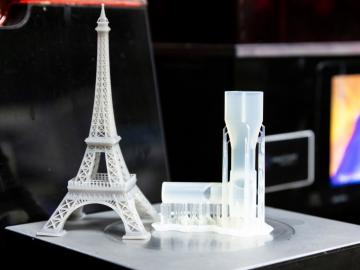
Filter News
Area of Research
- (-) Fusion and Fission (54)
- (-) Isotopes (35)
- (-) Materials (433)
- Advanced Manufacturing (34)
- Biological Systems (18)
- Biology and Environment (177)
- Biology and Soft Matter (5)
- Building Technologies (12)
- Chemical and Engineering Materials (4)
- Chemistry and Physics at Interfaces (11)
- Clean Energy (522)
- Climate and Environmental Systems (14)
- Computational Biology (6)
- Computational Chemistry (5)
- Computational Engineering (5)
- Computer Science (19)
- Data (1)
- Earth Sciences (1)
- Electricity and Smart Grid (3)
- Energy Frontier Research Centers (14)
- Energy Sciences (5)
- Fossil Energy (3)
- Fuel Cycle Science and Technology (3)
- Functional Materials for Energy (16)
- Fusion Energy (17)
- Geographic Information Science and Technology (3)
- Isotope Development and Production (3)
- Materials Characterization (2)
- Materials for Computing (36)
- Materials Synthesis from Atoms to Systems (13)
- Materials Under Extremes (12)
- Mathematics (1)
- National Security (79)
- Neutron Data Analysis and Visualization (4)
- Neutron Science (190)
- Nuclear Science and Technology (74)
- Nuclear Systems Modeling, Simulation and Validation (3)
- Nuclear Systems Technology (1)
- Quantum Condensed Matter (4)
- Quantum information Science (9)
- Reactor Technology (1)
- Renewable Energy (4)
- Sensors and Controls (5)
- Supercomputing (311)
- Transportation Systems (11)
News Type
News Topics
- 3-D Printing/Advanced Manufacturing (26)
- Advanced Reactors (10)
- Artificial Intelligence (10)
- Big Data (2)
- Bioenergy (11)
- Biology (5)
- Biomedical (12)
- Buildings (5)
- Chemical Sciences (34)
- Clean Water (3)
- Climate Change (5)
- Composites (9)
- Computer Science (19)
- Coronavirus (4)
- Critical Materials (13)
- Cybersecurity (4)
- Decarbonization (9)
- Energy Storage (35)
- Environment (17)
- Exascale Computing (3)
- Fossil Energy (1)
- Frontier (4)
- Fusion (27)
- Grid (6)
- High-Performance Computing (6)
- Irradiation (2)
- Isotopes (34)
- ITER (6)
- Machine Learning (5)
- Materials (74)
- Materials Science (80)
- Mathematics (1)
- Microscopy (27)
- Molten Salt (3)
- Nanotechnology (39)
- National Security (4)
- Net Zero (2)
- Neutron Science (34)
- Nuclear Energy (45)
- Partnerships (13)
- Physics (30)
- Polymers (17)
- Quantum Computing (3)
- Quantum Science (11)
- Renewable Energy (1)
- Security (4)
- Simulation (4)
- Space Exploration (5)
- Summit (2)
- Sustainable Energy (17)
- Transformational Challenge Reactor (3)
- Transportation (16)
Media Contacts

In June, ORNL hit a milestone not seen in more than three decades: producing a production-quality amount of plutonium-238

A team of scientists with ORNL has investigated the behavior of hafnium oxide, or hafnia, because of its potential for use in novel semiconductor applications.

Speakers, scientific workshops, speed networking, a student poster showcase and more energized the Annual User Meeting of the Department of Energy’s Center for Nanophase Materials Sciences, or CNMS, Aug. 7-10, near Market Square in downtown Knoxville, Tennessee.

Cadet Elyse Wages, a rising junior at the United States Air Force Academy, visited ORNL with one goal in mind: collect air.

Rose Montgomery, a distinguished researcher and leader of the Used Fuel and Nuclear Material Disposition group at ORNL, has been selected to participate in the U.S. WIN Nuclear Executives of Tomorrow, or NEXT, class of 2023 to 2024.

Autonomous labs are changing the nature of scientific investigation. Instead of humans manually orchestrating every part of an experiment, programmed equipment can carry out necessary functions. This workflow accelerates the pace of discovery by reducing the number of monotonous tasks that researchers must perform.

Takaaki Koyanagi, an R&D staff member in the Materials Science and Technology Division of ORNL, has received the TMS Frontiers of Materials award.

Timothy Gray of ORNL led a study that may have revealed an unexpected change in the shape of an atomic nucleus. The surprise finding could affect our understanding of what holds nuclei together, how protons and neutrons interact and how elements form.

It was reading about current nuclear discoveries in textbooks that first made Ken Engle want to work at a national lab. It was seeing the real-world impact of the isotopes produced at ORNL

Leigh R. Martin, a senior scientist and leader of the Fuel Cycle Chemical Technology group at ORNL, has been named a Fellow of the American Chemical Society for 2023.


